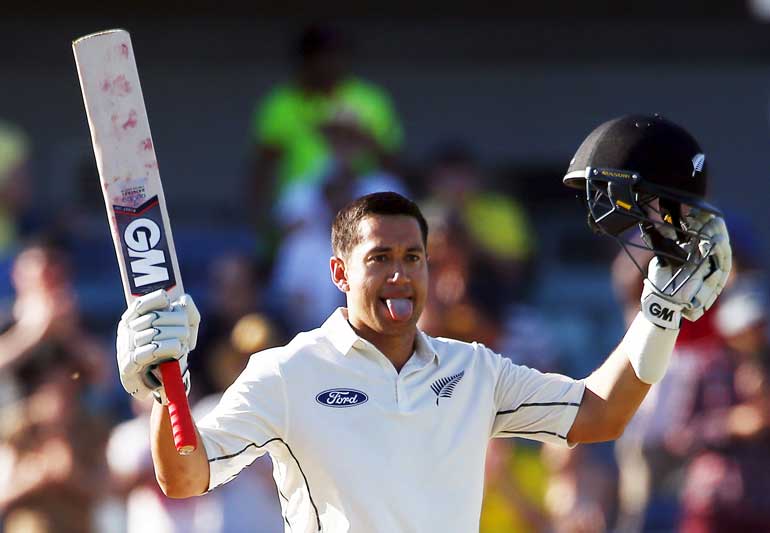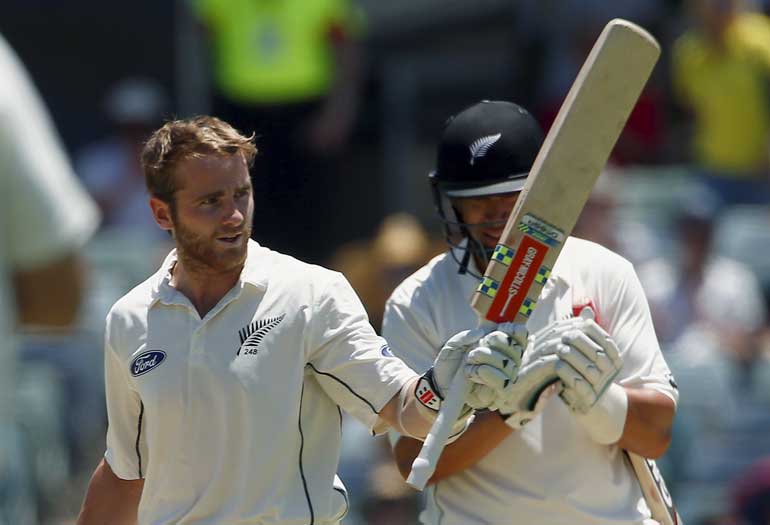Monday Jan 13, 2025
Monday Jan 13, 2025
Monday, 16 November 2015 00:00 - - {{hitsCtrl.values.hits}}

New Zealand’s Ross Taylor celebrates scoring his double century on the third day of the second cricket test match against Australia at the WACA ground in Perth, Western Australia, November 15, 2015. REUTERS

New Zealand’s Kane Williamson (L) is applauded by team mate Ross Taylor as he celebrates reaching his century during the third day of the second cricket test match against Australia at the WACA ground in Perth, Western Australia, November 15, 2015. REUTERS
Reuters: Ross Taylor scored the first double century by a New Zealander against Australia to drive the tourists to within 49 runs of the hosts’ tally on 510 for six at the close of play on the third day of the second test on Sunday.
The 31-year-old righthander shared a record partnership of 265 runs with Kane Williamson, who scored 166, as the tourists finally got on the front foot after losing the first test by 208 runs and conceding a torrent of runs at the start of the second.
Taylor’s innings was already the highest of his career and, after finishing the day on 235 not out, he could yet eclipse the 253 David Warner contributed to Australia’s first innings 559-9 declared.
Questions will be asked about the quality of the WACA wicket after more a than a thousand runs were scored in three days but Australia’s Mitchell Starc showed there was life in the track with one frightening spell of new-ball bowling.
The left-arm paceman hit the 160 kilometres per hour mark with one delivery, took a chunk out of New Zealand captain Brendon McCullum’s bat with another and created a string of chances which all failed to go to hand.
It was the more pedestrian pace of Josh Hazlewood that broke the third-wicket partnership when Williamson toe-ended an attempted pull to Mitchell Johnson at mid-on, while Mitchell Marsh’s 130-kph effort clean bowled McCullum for 27.
Starc (2-83) did get some reward for his fiery efforts with a full toss that BJ Watling (1) slapped to Nathan Lyon at point and Johnson (1-131) removed Doug Bracewell for 12 to claim his 311th test wicket.
That moved the 34-year-old ahead of Brett Lee and into fourth place in the list of Australian test wicket-takers with only Shane Warne, Glenn McGrath and Dennis Lillee ahead of him.
Throughout all that excitement, though, Taylor batted on assiduously and courageously through 308 balls, peppering the boundaries with 34 fours.
The partnership with Williamson, who scored his fourth century in nine innings this year, was the highest by any New Zealand pair against Australia and the ninth highest by any visiting batsmen in the country.
Resuming on 26 with New Zealand 140 for two, Taylor looked as unsettled as Williamson was assured at the other end for the first hour.
He looked more and more comfortable as the day wore on, however, and after Williamson secured his 12th test century, the former captain pipped him with his 13th soon after lunch by cutting spinner Lyon to the third man boundary.
Passing 5,000 career test runs on the way, he brought up the double century off Starc from his 31st four with yet another of the fine cover drives that had studded his innings.
Reuters: Australia’s Mitchell Starc bowled the fastest delivery ever measured at a test match when the fourth ball of his 21st over at the WACA on Sunday was clocked at 160.4 kilometres per hour.
The left-arm paceman fell just short of joining the “100 miles per hour” club as the speed of the yorker, which was dug out for no run by New Zealand’s Ross Taylor, translates into the imperial scale at 99.67 mph.
The recording of the speed of deliveries is a relatively recent development in the long history of cricket and an inexact science given the lack of uniformity in the speed gun technology utilised.
A delivery from Pakistan paceman Shoaib Akhtar in a one-day international against England in South Africa in 2003, which was measured at 161.3kph, is the fastest on record.
New Zealand batting coach Craig McMillan later called into the question whether Starc’s delivery was as fast as Australian broadcasters Channel Nine showed on the screen.
“Maybe someone in the (TV) truck was having a bit of fun,” McMillan told reporters at the WACA.
“It looked pretty similar to a lot of the other deliveries throughout the day that were closer to 150 than 160. I’m not sure whether maybe the wrong button was pushed or what.
“I was a bit surprised when I saw it come up on the TV ... I just wonder whether there was a technical problem down at the truck that maybe led to that.”